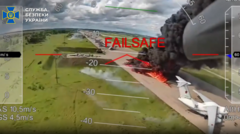### Summary: On June 1, Ukraine initiated a daring drone strike known as "Spider Web," deploying over 100 drones to key Russian airbases, resulting in significant damage to military assets. This operation showcased innovative tactics and highlighted the evolving landscape of modern warfare.
### Title: Ukraine's "Spider Web" Drone Assault: A New Era of Warfare

### Title: Ukraine's "Spider Web" Drone Assault: A New Era of Warfare
### Description: Ukrainian forces successfully execute an unprecedented drone operation, targeting Russian military airbases in a bold strategic move.
On June 1, Ukraine launched a stunning and meticulously planned assault dubbed "Spider Web," deploying over 100 drones against Russian airbases, demonstrating remarkable military ingenuity. The operation, 18 months in the making, targeted nuclear-capable bombers in a coordinated effort that elicited explosions across multiple Russian time zones, from Murmansk to Amur, covering over 8,000 kilometers.
The Russian Defence Ministry confirmed the drone strikes impacted five regions—Murmansk, Irkutsk, Ivanovo, Ryazan, and Amur—though they claimed that damage was limited to just two areas. However, early assessments indicated that 41 strategic bombers were hit, with Ukraine asserting that at least 13 were destroyed.
The operation's logistics revealed astonishing complexity, with drones smuggled into Russia in wooden cabins atop unsuspecting lorries, concealed beneath detachable roofs. This clandestine strategy allowed the drones to be launched from strategically parked vehicles without alerting drivers, some of whom reported attempting to thwart the drones with stones. Eyewitness accounts from Russian truck drivers revealed they were instructed to deliver these inconspicuous wooden structures, only to be shocked when drones suddenly emerged.
Ukrainian President Volodymyr Zelensky, who oversaw the operation, hailed the successful deployment of the 117 drones, emphasizing the meticulous planning that took "one year, six months and nine days." While President Zelensky assured that individuals who facilitated the operation were already removed from Russian territory, local authorities in Irkutsk initiated investigations into a Ukrainian-born suspect.
Images shared by Ukrainian intelligence showed the drones being stored and prepared, indicating a calculated approach to the strikes. Experts noted the drones were likely simple quadcopters equipped with substantial payloads, while remote piloting was achieved through satellite or internet connections, allowing for precise strikes despite potential Russian electronic jamming.
Although Russian military reports downplayed the severity of the attacks, imagery and videos confirmed significant damage to Russian assets, including the Tu-95 and Tu-22 bombers. The potential financial blow to Russia was estimated at approximately $7 billion, prompting a muted response from state media, which quickly buried the story amid celebratory reactions from Ukrainians, who hailed the operation as a monumental success.
As Ukraine continues to innovate in warfare tactics, this audacious attack sends a pivotal message to both Russia and Western allies about the evolving nature of military engagement in the ongoing conflict. Zelensky remarked that these actions would undoubtedly make their way into future history books, solidifying Ukraine's strategic positioning in the conflict.





















